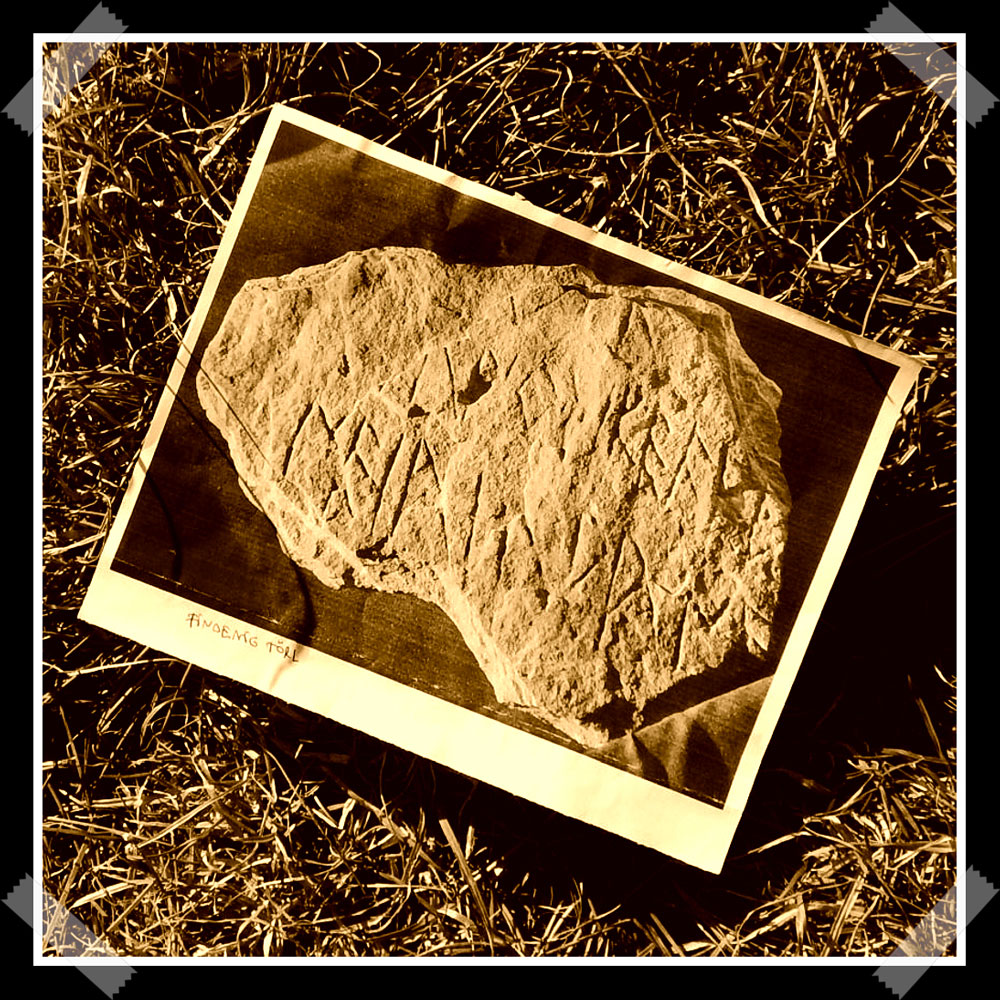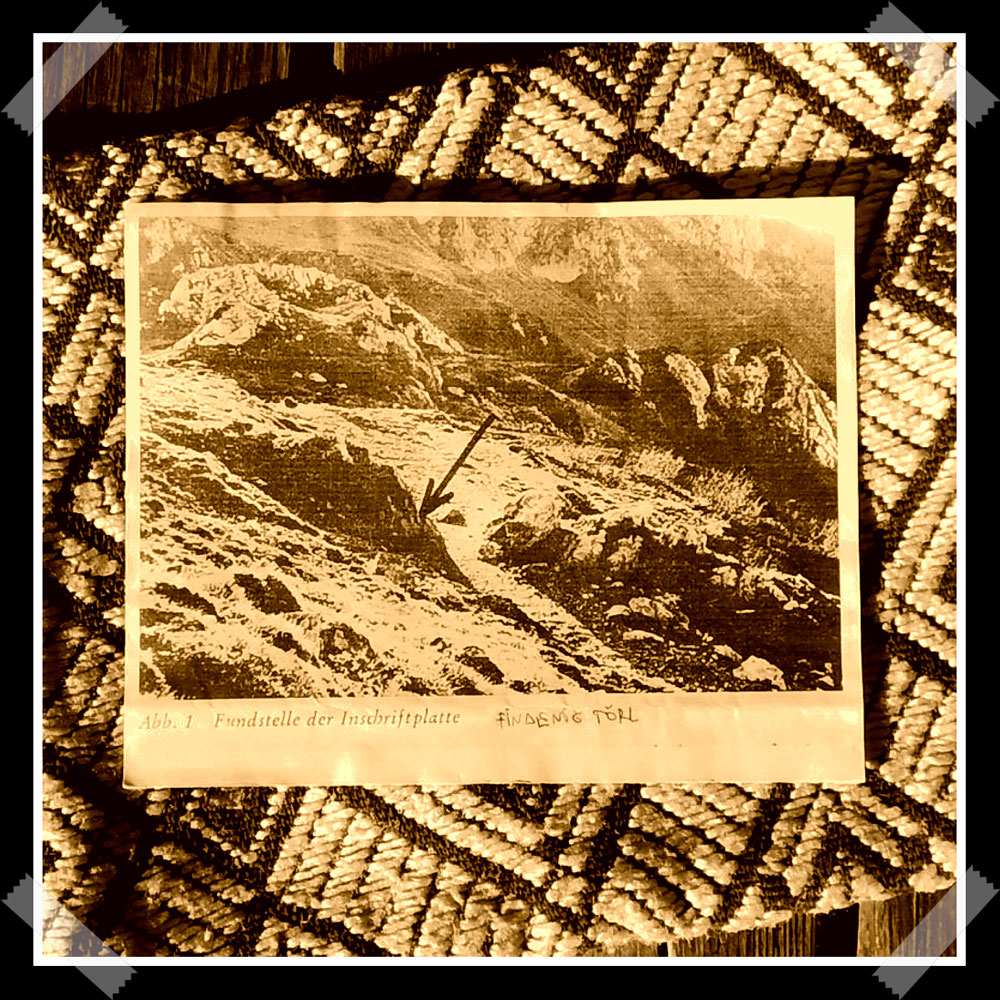By Gerhard Hallstatt
Essay
Findenig Törl
Kärnten / Carinthia
Report: 27.09.1997
For hours now I had been searching for these mysterious inscriptions on the Findenig Törl, a pass at an altitude of 1800 m, a threshold on the ridge of the Carnic Alps which connects Austria and Italy, Kärnten (Carinthia) and Friaul (Friuli). Somewhere among these beautiful peaks there apparently were some rune-like inscriptions to be found, carved into the rock more than two thousand years ago by the ancient Veneti who lived in and around the Alps. These inscriptions are well known among archaeologists, since petroglyphs executed by the Veneti are very rare. Unfortunately, I had no exact description of their location – and my map, although quite detailed, had no symbol for an archaeological site. I only knew the name: Findenig Törl. The name “Törl” means little gate, while the word “Findenig” probably refers to the Veneti: “The little Gate of the Veneti.” But since Findenig is also reminiscent of “to find,” it could also be called – in a more symbolic manner – “The Door of Finding.” On some maps the Findenig Törl is also called Lodin Törl because the peak to the west of this Törl has two names – Findenig Kofel in German and Monte Lodin in Italian. Not much is known about the Veneti who seem to have some close connections to the much more famous Etruscans. Yet in Alpine folklore their existence survives in many legends about the Venedigermandl, “the little Veneti,” wise little men from the South who were very successful in discovering ores, minerals, and precious stones in the rocky wastelands of the Alps. These legends mention that they used some strange tools; for example, a Bergspiegel, or “mountain mirror,” and use of a dowsing rod is also very probable. It thus seems that they were aware of occult practices. They would spend some time in the mountains, only to disappear again, usually with a huge bag full of seemingly worthless rocks. The people of the mountain villages became envious – did they find a hidden treasure? Some legends end with Austrians visiting Venice many years later – only to discover that some of these little Venedigermandl now lived in rich palazzi… Some of the blood of the ancient Veneti also seems to be coursing within me. Growing up close to my beloved mountains, maybe my fascination for stones, caves, and sacred sciences like alchemy and geomancy is part of my ancestral heritage. And perhaps right then on that pass I was a Venedigermandl as well, this time not searching for ores and precious stones but for the petroglyphs of my ancestors. So in some way I was looking for my roots as well – roots on the ridge, roots on and inside the mountains. Yet, thus far, I seemed to be less successful than the Venedigermandl – maybe I should have brought that mountain mirror or a dowsing rod with me… The weather was very friendly and warm, the landscape with its peaks and valleys was incredibly beautiful, and during my quest I came across some lovely Edelweiss flowers and encountered numerous mountain goats – but I was unable to find the inscriptions. When I looked at my watch, it was already late afternoon – the sun would set within three hours. If I stayed on this ridge too long, it would be already very dark in the woods close to the village where I had my room. Unfortunately, I was not at all prepared for a cold night among the peaks. On my map I discovered a shorter path back to the valley. I decided to take it. But after half an hour this trail disappeared, and I found myself inside a labyrinth of rocks and brush without any marks, without any path. I was helpless. It had been very easy to find the Findenig Törl – but it seemed far more difficult to leave it. I had spent the whole day here by myself, with no one to ask about the petroglyphs – and now there was no one to ask about the right way back. But then all of a sudden there was someone… not a Venedigermandl, but a man who looked like a hunter, dressed in bright green. He had no rifle, only a pair of field glasses. He seemed to be around fifty years old, good-natured, unobtrusive. In some way he reminded me of the angel played by Bruno Ganz in Wim Wender’s movie Wings of Desire. Where had he come from so fast? It seemed that he had been watching me for some time, and obviously he had noticed that I had lost my way. I greeted him and asked for the best way down to the valley. At first he did not answer but instead used his field glasses to survey a distant slope. I followed his eyes, expecting to see a mountain goat or an ibex, but then I spotted someone else walking there. And in some way this other hiker resembled me, with similar clothes and a similar rucksack. Maybe this wanderer was also searching for the inscriptions? Then the hunter turned to me and explained which way I had to take. I said ‘thank you’ and ‘good bye’ and left. Only after a few meters did I remember that I had forgotten to ask him for the location of the inscriptions. Certainly, he would know their whereabouts – and with his assistance maybe there was still enough time to see them before descending… I turned around to ask him – and I was almost shocked when I saw that this hunter had completely vanished. Very soon I found the path again. Everything was very easy now. But it was already pitch-dark when I arrived at the village. And only later in the evening did I start to wonder if this hunter really had been a hunter, a human being. Maybe I should have touched him… Maybe he was “an angel out of the blue,” an angel without wings who spoke with a strong Carinthian dialect, a dweller of the threshold, a genius loci of the Findenig Törl who only appeared in moments of distress. Several legends about people lost in woods, or lost in the mountains, who have mysterious encounters came to mind. And maybe this was the mission of this magical hunter as well – maybe he had disappeared so fast so he could also help the other hiker. Mere days later, while still exploring some archaeological sites in Kärnten / Carinthia, someone in another village told me that it was impossible to find the inscription at the Findenig Törl – it had been cut out of the rocks several decades ago and was now displayed in the Municipal Museum of Villach (Museum der Stadt Villach), together with other petroglyphs that had also been removed from mountains and alpine meadows in this area. For me this was like a sacrilege. These inscriptions should remain forever where they were found – only there did they make sense. So even the bright green hunter would have been unable to show them to me.
CREDITS
Text,translation and photos: Gerhard Hallstatt.
Translation: Gerhard Hallstatt, Arrowyn.
PREVIOUS PUBLICATIONS
An early version of this text appeared in:
Magazine Hex 4 (Portland, Oregon, USA)
CD Book Pera Ascognüda, Tera Salvaria, Ladinia, Italia.
This text was also presented live in the Dolomites on 22.06.2013 at the festival Tera Salvaria in Sas Dlacia, St Ciascian (BZ), Val Badia.
Gerhard Hallstatt was accompanied by the guitar played by Pablo (Sangre de Muerdago).
Tags
Archaelogy
Ethnology
Runic Inscriptions
Folklorismus
Author
Gerhard Hallstatt - © 21.06.2008


